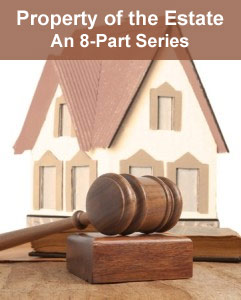 #5 of 8 in Series — Previous Article #4: Judicial Estoppel Normally Used to Prevent Conflicting Litigation
#5 of 8 in Series — Previous Article #4: Judicial Estoppel Normally Used to Prevent Conflicting Litigation
In the vast majority of consumer cases, assets are easily identifiable and can be listed and valued on schedules A and B with limited investigation. However, one asset that may be both difficult to identify and value is the debtor’s interest in any causes of action that he or she may have against a creditor or other third party. In fact the debtor may not even realize that there is a potential claim, such as a creditor’s violation of the Fair Debt Collection Practices Act, or an action against a former employer for wrongful termination. The attorney’s failure to properly list an asset may bar the debtor from pursuing an action at a later time. Yet bad legal advice does not relieve the debtor of the consequences of the incorrect filing. In the case Cannon-Stokes v. Potter, 453 F.3d 446 (7th Cir. 2006)[2] Judge Easterbrook wrote “[a] lawyer is the client’s agent, and the client is bound by the consequences of advice that the client chooses to follow. Cannon-Stokes might as well say that she is free to ignore any contract that a lawyer advised her to sign with her fingers crossed behind her back. The lawyer’s role as agent is why the Supreme Court held in United States v. Boyle, 469 U.S. 241, 105 S.Ct. 687, 83 L.Ed.2d 622 (1985), that a taxpayer could not avoid paying interest and penalties occasioned by his lawyer’s mishandling of the return. Just so here: a debtor in bankruptcy is bound by her own representations, no matter why they were made, at least until the debtor moves to amend the disclosures and pay the creditors their due (a step that, to repeat, Cannon-Stokes has not taken). The remedy for bad legal advice lies in malpractice litigation against the offending lawyer.”
However, that does not absolve the debtor from any responsibilities, as they could be penalized for following bad advise from their attorney and subject to fines, revocation of the bankruptcy, and/or criminal charges.
Judicial Estoppel Normally Used to Prevent Conflicting Litigation
Judicial Estoppel Applied in Bankruptcy When Debtor Belatedly Pursues Undisclosed Claim
Judicial Estoppel Motivates Full and Truthful Disclosures From Debtor Bankruptcy Filings
Chapter 7 and Chapter 13 Bankruptcy Codes Conflict
We interpret this to mean that if the court already has a confirmed plan in place, it is assumed that the debtor can manage these funds, and that assets not necessary for the fulfillment of the plan should be returned to the debtor.
Four Judicial Lines of Reasoning Regarding Bankruptcy Estate
- Estate termination approach: All property of the estate vests in the debtor upon confirmation and that the estate terminates at that point. Under this approach, there is no property of the estate after confirmation, only property of the debtor. This approach takes a literally reading of Section 1327(b) in vesting all property regardless of when it was acquired in the debtor. It has been criticized because it fails to give effect to the language of section 1306(a), which specifically provides that all property acquired between commencement of the case and closing, conversion or dismissal is property of the estate. See Cal. Franchise Tax Bd. v. Jones (In re Jones), 420 B.R. 506, 514-515 (9th Cir. B.A.P. 2009). However, even under this approach, a debtor may have to amend schedules to add an after acquired asset even if it is not property of the estate. As discussed earlier undisclosed assets remain property of the estate and may not revest to the debtor.
- Estate Preservation Approach: All property of the estate at confirmation remains property of the estate until discharge, dismissal or conversion. This approach is criticized because it fails to address the language of section 1327(b), which specifically provides for the vesting of property of the estate in the debtor upon confirmation of the plan. See Security Bank of Marshaltown v. Neuman, 1 F.3d 687, 690-691 (8th Cir. 1993) which held that confirmation is not relevant to determining whether property is property of the estate. Instead the only relevant events are commencement of the case and dismissal, closing or conversion of the case. This approach has been criticized as it would render section 1327(b) meaningless when it clearly states that property of the estate vests in the debtor upon confirmation of the plan.
- Estate reconciliation approach: Estate property existing at confirmation vests in the debtor but subsequently acquired property becomes property of the estate. See In re Eldridge, 09-03589-8-SWH, 2013 WL 64756 (Bankr. E.D.N.C. Jan. 4, 2013): Residence vested in the debtor at confirmation and was not property of the estate; homeowners association did not need stay relief to pursue post-petition assessment under state law. The debtor was not required to pay association’s attorney fees for unnecessary stay relief motion. See also Crouser v. BAC Home Loans Servicing, L.P. (In re Crouser), 476 B.R. 340 (Bankr. S.D. Ga. Aug. 20, 2012): Vesting at confirmation did not prevent property acquired post-confirmation from coming into the estate. Damages for willful stay violation were property of the estate that must be turned over to trustee for distribution.
- Estate transformation approach: Chapter 13 plan confirmation returns all property of the bankruptcy estate to the Debtor that is not necessary for the fulfillment of the confirmed plan. This approach has been criticized because it also ignores the language of section 1306(a) which, by its terms, makes no distinction between “property necessary to complete the plan,” and any other property. See In re Waltower, No. 08-12864, 2012 WL 4758043 (Bankr. S.D. GA. Sept. 7 2012): Surrender of property to mortgagee through a confirmed plan and revesting property in debtors under §1327(b) removed property from the estate and automatic stay terminated; neighbor is entitled to §362(j) order confirming that the automatic stay does not protect debtors from a state court nuisance action when mortgagee did not foreclose or maintain property after surrender.
Seventh Circuit Court Adopts Estate Transformation Approach
On the other hand, creditors cannot attempt to sue the debtor for a post-petition debt in an effort to garnish their wages or collect the debt. In this case, the bankruptcy attorney would be responsible to write to contact the creditor and state, “You cannot do that because the wages that they are earning are property of the estate because they are necessary for the fulfillment of the plan. After the bankruptcy is over, you can whatever the hell you want to do, but while the bankruptcy is going on, this is property of the estate and you can’t touch it.”
Next Article in Series: Cause of Action Assets Must Be Disclosed Whether Property of Estate or Debtor
Sources: [1] Cornell University Law School Legal Information Institute; [2] Justia; [3] OpenJurist; [4] CaseText; [5] CourtListener
Disclosure required by 11 U.S.C. § 528(a)(3): We, the law office of Tom Scott & Associates, P.C., are a debt relief agency. We help people file for bankruptcy relief under the Bankruptcy Code.
